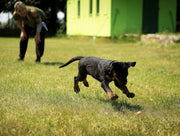
You probably have heard of hay fever in humans, also called allergic rhinitis. This condition affects between 10 and 30 percent of the U.S. population. Symptoms and severity vary but often include sneezing. Dogs can also get hay fever, and it may affect as many as 1 in 10 dogs.
While the canine hay fever name suggests a relationship with hay, hay has not been shown to cause an allergic reaction. On the other hand, common environmental allergens such as pollen and grass have.
Let's go over what hay fever is, how to recognize its common symptoms, and the best ways to prevent it.
What is hay fever?

Dog hay fever is an allergic reaction caused by the body's response to grass, tree, or plant pollen in the air. As its name suggests, it is associated with the hay season: the spring and summer months. Hay fever is a type of "atopy" due to allergens penetrating the skin and causing a variety of undesirable symptoms.
Can dogs get hay fever?
Dogs can get hay fever just like humans. The difference between human hay fever and dog hay fever is the symptoms. While we may have a runny nose or sneeze a lot, our canine companions may instead have itchy skin and irritated eyes.
About 10% of the dog population may develop hay fever, and it may become an issue for the ones who are more sensitive to these allergens. In addition, dogs may start to scratch a lot, leading to infections.
Which dogs are more susceptible to hay fever?

According to veterinarians, a few breeds are more likely to get hay fever. These dog breeds include:
- Pit Bull Terrier
- Boston Terrier
- Wire-haired Terrier
- West Highland White Terrier
- Cairn Terrier
- Bichon Frise
- Boxer
- Cocker Spaniel
- German Shepherd
- Golden Retriever
- Dalmatians
- Irish Setters
- Schnauzers
- Poodles
These dog breeds may be prone to hay fever due to facial shape, the shape of their nose, and the type of coat.
Tell me the most common cause of hay fever in dogs?
Environmental allergens are most likely to cause hayfever in dogs, such as:
- Pollen
- Grass
- Dust
Because pollen and grass are most often present in the air during the spring and summer months, this is also when dogs are more prone to develop an allergic reaction. Therefore, hay fever is sometimes referred to as a pollen allergy or seasonal allergies.
House dust mites may also cause hay fever in dogs. For this reason, the best ways to prevent hayfever in dogs often involve limiting exposure to these allergens. We will cover some of these solutions below.
Tell me the symptoms of hay fever in dogs?

Before going into the common symptom or symptoms associated with dog hay fever, please remember to consult your vet. Hay fever symptoms tend to be broad and may be related to other conditions, such as dog dry eye.
A proper consultation will allow your vet to rule out these other conditions and recommend the best course of action.
Also, remember that these symptoms are common with environmental allergies, pollen allergies, skin problems, and even a food allergy.
Here are the common dog hay fever symptoms:
- Sneezing
- Watery, irritated eyes
- Runny nose
- Skin irritation, itchiness
- Rashes on the paws or skin
- Irritated throat
- Rubbing their face on the floor or furniture
- Sore or bald patches of skin due to excessive itching
An excellent way to rule out hay fever with the help of your vet is to track your dog's symptoms throughout the year. If your dog's symptoms persist even in the winter months, your dog's allergic reaction may not be related to environmental allergens.
7 ways to prevent or reduce canine hay fever symptoms

Sometimes, your dog's pollen allergy or tree pollen allergy can get out of hand. As a result, your dog may suffer from daily irritated eyes and itchiness. Both can lead to secondary infections such as eye infections or your dog constantly biting his skin.
Start by consulting your veterinarian
Pollen counts are higher in the spring and the summer, which is why it's called the hay fever season. A visit to your local veterinary practice can help you find treatment immediately. Doggy hay fever affects as much as 10% of the dog population, and some dogs will develop a persistent itch.
Boost skin & immune system
A great and healthy way to support your dog's skin is to supplement his or her diet with Omega 3 fatty acids. The EPA and DHA contained in Omega 3 fatty acids have been shown to strengthen dogs' skin and support their immune systems, which may help reduce itchiness.
Another great benefit of Omega 3s is that they most of the time come in the form of salmon oil, which is a flavor most dogs are fond of. According to research, salmon oil may lead to less irritated skin and even help with your dog's food allergy.
Get flea prevention and treatment for your dog
While parasites like fleas do not cause canine hay fever, they may worsen your dog's symptoms. Please discuss this issue with your vet so he can recommend good flea prevention for your dog. In addition, some dogs are allergic to flea saliva and may develop a rash around the bite and intense itchiness.
Brush your dog daily
Brushing your dog's coat after they have been outside may help if your dog suffers from hay fever, especially during the pollen season. Brushing will also be good practice for removing dirt and debris and preventing matted hair.
Wipe your dog's skin after daily walks

Many shorter dogs will develop a skin rash on their bellies after going outside. This may be because grass came in direct contact with their skin. As simple as it may sound, wiping down your dog's skin with a damp towel may help remove pollen and grass allergens and reduce your dog's symptoms.
Bathe your dog regularly
Bathing your dog is another way to remove dust, pollen, and grass from your dog's skin and coat while also getting a chance to soothe and moisturize the skin. Your vet may prescribe medicated shampoos, and you should also look into oatmeal-based shampoo and conditions that may help your dog feel better.
Install HEPA filters in your home and car
Dogs spend a considerable amount of time inside homes and may also get into your car. Nowadays, it is pretty easy to get a HEPA filter for your home's air conditioning system that will help stop common allergens spread inside your home. You can also get a pollen filter for your car.
Keeping the windows closed during the spring and the summer and regularly dust-cleaning your home may be other ways to help your dog with hay fever further.
How do you treat atopy in dogs?
Atopy is a term often used to refer to skin allergies in dogs. Atopy may not have a treatment, but there are various ways vets can help your dog's symptoms by using prescribed antihistamine medication or injections. Please ask your vet for the best course of action.




